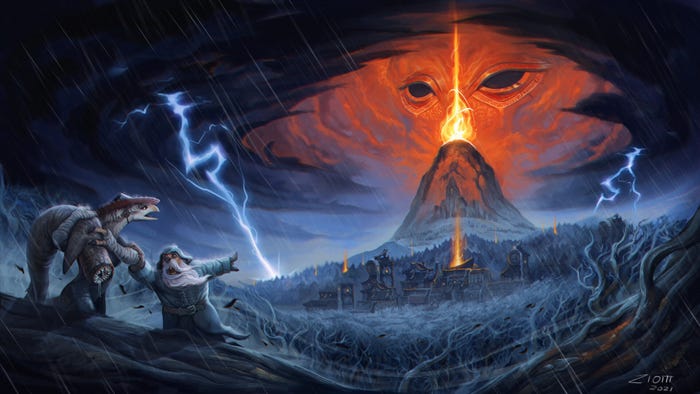Gamasutra and Game Developer spotlight ten talented artists in the game industry who've created outstanding work in the past year, championing the developers who inspire us to do better.
November 5, 2012

Author: by GD mag, Gamasutra staff
Making games may be largely a team effort these days, but that doesn't mean we shouldn't acknowledge the individuals who make outstanding contributions to the industry as well. Gamasutra and its sister magazine Game Developer magazine have put together a "Power 50" list of people in the game industry who have stood out for doing work in the last year that is new, different, or better. Here, we've highlighted ten talented developers who've created exemplary work with the art in their games, championing the artists who inspire us to do better. We are also recognizing talented individuals in the fields of Audio, Business, Design, Evangelism, and Programming in separate posts. The following names are not ranked -- they are listed alphabetically by last name. Sheldon Carter Digital Extremes Hand-painted, cel-shaded visuals—check. Ruthless heavy-metal soundtrack—check. Sheldon Carter's creative direction in The Darkness II is, well, dark, and that's exactly what a game about mob bosses with supernatural powers should be. Kudos to Carter and his team for building The Darkness II's unified and seamless aesthetic vision.  Sheldon Carter Mariel Cartwright Reverge Labs The fighting game genre may be alive and well these days, but the impeccably fluid, detailed 2D animation we loved about the genre in the 1990s is practically nowhere to be seen—except in Reverge Labs's Skullgirls, anyway. Thanks to lead animator Mariel Cartwright, Skullgirls looks every bit the 2D fighter of our dreams, with hand-drawn characters and backgrounds that ooze personality and craftsmanship out of every frame. Step aside, Street Fighter III: Third Strike; Skullgirls has set a new standard.
Sheldon Carter Mariel Cartwright Reverge Labs The fighting game genre may be alive and well these days, but the impeccably fluid, detailed 2D animation we loved about the genre in the 1990s is practically nowhere to be seen—except in Reverge Labs's Skullgirls, anyway. Thanks to lead animator Mariel Cartwright, Skullgirls looks every bit the 2D fighter of our dreams, with hand-drawn characters and backgrounds that ooze personality and craftsmanship out of every frame. Step aside, Street Fighter III: Third Strike; Skullgirls has set a new standard.  Daniel Dociu Daniel Dociu ArenaNet Guild Wars 2 looks like art director Daniel Dociu took a bunch of beautifully detailed concept art and somehow plugged it directly into a game. That Dociu could lead ArenaNet's art team to do that much is impressive; that he managed to do that in an MMO, where visuals must often be sacrificed for performance's sake, is nothing short of spectacular. Simon Flesser Simogo In early 2012, Simogo's Beat Sneak Bandit (pictured) rocked our worlds (and snagged Best Mobile Game in the Independent Games Festival 2012 awards) with its cartoony, syncopated charm. The credit for said charm belongs to Simogo cofounder Simon Flesser, who was the art-and-sound whiz behind BSB's whimsy. In an interview with Gamasutra, Flesser described BSB as "Cool, but in a silly cartoon show kind of way." We want more of that. Dan Roberts The Blast Furnace Now that we're done ranting about the overuse (and abuse) of "retro" aesthetics, we thought we'd call out a rather exceptional case. New Activision mobile dev studio The Blast Furnace made an intriguing Pitfall! iOS game that we would describe as "new retro," if that makes sense. Under Dan Roberts's artistic direction, Pitfall! for iOS brings us into a world of cartoony-looking untextured polygons that look kind of like the original Pitfall! and Super Mario 64 had a video game baby. It's kind of how we imagine the original Pitfall! would look if we were trapped inside of it. Robert Nelson Rockstar Games If you look at any recent Rockstar title, it's clear the studio has a real affinity for film. Its game cinematics often borrow editing and compositional techniques from movies and other visual media, and under creative director Robert Nelson's direction in Max Payne 3, the studio experimented with some new visual techniques from outside the traditional GTA wheelhouse. Max Payne 3 tells the story of a haggard ex-cop with a crippling addiction to both booze and painkillers, and Rockstar's cinematics go a long way toward reinforcing the character's tormented mental state. The camera often flickers out of focus, key lines of dialogue linger onscreen to emphasize Max's guilt, and clever split-screen action scenes make poignant moments seem more frantic and distressed. These visual techniques are subtle on their own, but when combined they really elevate the game's depressing and action-fueled narrative.
Daniel Dociu Daniel Dociu ArenaNet Guild Wars 2 looks like art director Daniel Dociu took a bunch of beautifully detailed concept art and somehow plugged it directly into a game. That Dociu could lead ArenaNet's art team to do that much is impressive; that he managed to do that in an MMO, where visuals must often be sacrificed for performance's sake, is nothing short of spectacular. Simon Flesser Simogo In early 2012, Simogo's Beat Sneak Bandit (pictured) rocked our worlds (and snagged Best Mobile Game in the Independent Games Festival 2012 awards) with its cartoony, syncopated charm. The credit for said charm belongs to Simogo cofounder Simon Flesser, who was the art-and-sound whiz behind BSB's whimsy. In an interview with Gamasutra, Flesser described BSB as "Cool, but in a silly cartoon show kind of way." We want more of that. Dan Roberts The Blast Furnace Now that we're done ranting about the overuse (and abuse) of "retro" aesthetics, we thought we'd call out a rather exceptional case. New Activision mobile dev studio The Blast Furnace made an intriguing Pitfall! iOS game that we would describe as "new retro," if that makes sense. Under Dan Roberts's artistic direction, Pitfall! for iOS brings us into a world of cartoony-looking untextured polygons that look kind of like the original Pitfall! and Super Mario 64 had a video game baby. It's kind of how we imagine the original Pitfall! would look if we were trapped inside of it. Robert Nelson Rockstar Games If you look at any recent Rockstar title, it's clear the studio has a real affinity for film. Its game cinematics often borrow editing and compositional techniques from movies and other visual media, and under creative director Robert Nelson's direction in Max Payne 3, the studio experimented with some new visual techniques from outside the traditional GTA wheelhouse. Max Payne 3 tells the story of a haggard ex-cop with a crippling addiction to both booze and painkillers, and Rockstar's cinematics go a long way toward reinforcing the character's tormented mental state. The camera often flickers out of focus, key lines of dialogue linger onscreen to emphasize Max's guilt, and clever split-screen action scenes make poignant moments seem more frantic and distressed. These visual techniques are subtle on their own, but when combined they really elevate the game's depressing and action-fueled narrative.  Vincent Perea (left) Vincent Perea Disney Mobile Design aside, the Disney-published Where's My Water? really stands out because of its visual style. Illustrator/designer Vincent Perea uses a simple, personality-packed cartoon aesthetic with a fairly minimalist approach. Perea's fluid animations and adorable character designs manage to inject the experience with a ton of charm—which is particularly impressive considering the screen is filled with little more than dirt and concrete most of the time. Brian Provinciano VBlank Entertainment "Retro" is probably the most-overused term in video games these days. Everything with visible pixels, Tempest-style vectors, or low-resolution textures can be called "retro," and we're kind of tired of it. However, there is something to be said for getting retro right, and Retro City Rampage creator Brian Provinciano knows this. It takes more than a crash course in pixel art to make a proper retro game; Provinciano's deep understanding of the NES hardware's capabilities and limitations were instrumental in making Retro City Rampage ring true to the old-school. Thomas Shahan Northway Games Next time you have a hard time finding an artist for your game, try looking around on Wikipedia. That's how Incredipede dev Colin Northway found photographer/woodblock-print artist Thomas Shahan, anyway; Northway was reading the entry for "jumping spiders," saw one of Shahan's illustrations, and tracked him down from there. While we may not be tremendous fans of spiders (jumping or otherwise), we have to admit that we can't think of a better match than insect-specialist Shahan for a game that is "about life and feet."
Vincent Perea (left) Vincent Perea Disney Mobile Design aside, the Disney-published Where's My Water? really stands out because of its visual style. Illustrator/designer Vincent Perea uses a simple, personality-packed cartoon aesthetic with a fairly minimalist approach. Perea's fluid animations and adorable character designs manage to inject the experience with a ton of charm—which is particularly impressive considering the screen is filled with little more than dirt and concrete most of the time. Brian Provinciano VBlank Entertainment "Retro" is probably the most-overused term in video games these days. Everything with visible pixels, Tempest-style vectors, or low-resolution textures can be called "retro," and we're kind of tired of it. However, there is something to be said for getting retro right, and Retro City Rampage creator Brian Provinciano knows this. It takes more than a crash course in pixel art to make a proper retro game; Provinciano's deep understanding of the NES hardware's capabilities and limitations were instrumental in making Retro City Rampage ring true to the old-school. Thomas Shahan Northway Games Next time you have a hard time finding an artist for your game, try looking around on Wikipedia. That's how Incredipede dev Colin Northway found photographer/woodblock-print artist Thomas Shahan, anyway; Northway was reading the entry for "jumping spiders," saw one of Shahan's illustrations, and tracked him down from there. While we may not be tremendous fans of spiders (jumping or otherwise), we have to admit that we can't think of a better match than insect-specialist Shahan for a game that is "about life and feet."  Thomas Shahan Randy Smith Tiger Style Games With Waking Mars, Tiger Style Games founder Randy Smith led his dev team to make something atmospheric, curious, and gorgeous—and as we're looking at all the different ways mobile game devs try to make their work visually stand apart from the pack, we think that Smith and his team are on the right track. In an interview with Gamasutra, Smith described Waking Mars's aesthetic as "a combination of fine details and abstract implication...not realistic, exactly, but believable." We weren't sure what to expect when you described your game as "action gardening," Smith, but you and your team ended up nailing it. [You can subscribe to Game Developer</> magazine in physical or physical/digital combo form now.]
Thomas Shahan Randy Smith Tiger Style Games With Waking Mars, Tiger Style Games founder Randy Smith led his dev team to make something atmospheric, curious, and gorgeous—and as we're looking at all the different ways mobile game devs try to make their work visually stand apart from the pack, we think that Smith and his team are on the right track. In an interview with Gamasutra, Smith described Waking Mars's aesthetic as "a combination of fine details and abstract implication...not realistic, exactly, but believable." We weren't sure what to expect when you described your game as "action gardening," Smith, but you and your team ended up nailing it. [You can subscribe to Game Developer</> magazine in physical or physical/digital combo form now.]
You May Also Like





